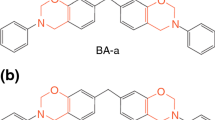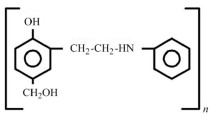Abstract
The high-temperature behavior of a fast curing commercial phenolic resin, used as a binder in commercial car brake pads, has been investigated. The research comes from the fact that a temperature in excess of 300 °C can be reached on the surface pad in case of severe braking conditions. At this temperature, the decomposition of the resin may not only result in detrimental effects for the braking capability of the pads, but also result in a significant increase in their wear rate. The phenolic resin alone and in association with other pad ingredients (master batch), and the friction material, obtained after curing treatments, were analyzed. The main degradation steps of the phenolic resin were identified, as concerns the relevant chemical decomposition processes. The degradation of the methylene and phenol groups turned out to be the most important in terms of mass loss. In the master batch and in the consolidated friction material, the onset temperature of these processes is influenced by the presence of the other ingredients, with particular regard to some metal components. A reduction of the resin degradation onset temperature of 51 °C was observed between the pure resin and the friction material.





Similar content being viewed by others
References
Bijwe J. Composites as friction materials: recent developments in non-asbestos fiber reinforced friction materials—a review. Polym Compos. 1997;18:378–96.
Anderson AE. Friction and wear of automotive brakes. ASM Handb. 1992;18:569–77.
Ingo GM, D’Uffizi M, Falso G, Bultrini G, Padeletti G. Thermal and microchemical investigation of automotive brake pad wear residues. Thermochim Acta. 2004;418:61–8.
Stanford MK, Jain VK. Friction and wear characteristics of hard coatings. Wear. 2001;251:990–6.
Torre C, Mattutino G, Vasino V, Robino C. Brake linings: a source of Non-GSR particles containing lead, barium and antimony. J Forensic Sci. 2002;47(3):494–504.
Plachá D, Vaculík M, Mikeska M, Dutko O, Peikertová P, Kukutschová J, Mamulová Kutláková K, Růžičková J, Tomášek V, Filip P. Release of volatile organic compounds by oxidative wear of automotive friction materials. Wear. 2017;376–377:705–16.
Chandra Verma P, Ciudin R, Bonfanti A, Aswath P, Straffelini G, Gialanella S. Role of the friction layer in the high-temperature pin-on-disc study of a brake material. Wear. 2016;346–347:56–65.
Federici M, Gialanella S, Leonardi M, Perricone G, Straffelini G. A preliminary investigation on the use of the pin-on-disc test to simulate offbrake friction and wear characteristics of friction materials. Wear. 2018;410–411:202–9.
Rosu D, Varganici C-D, Rosu L, Mocanu OM. Thermal degradation of thermosetting blends, thermal degradation of polymer blends. In: Visakh PM, Arao Y, editors. Composites and nanocomposites, engineering materials. Cham: Springer; 2015.
Chen Y, Chen Z, Xiao S, Liu H. A novel thermal degradation mechanism of phenol–formaldehyde type resins. Thermochim Acta. 2008;476(1–2):39–43.
Santamaria Razo D, Pellerej D. Control of gaseous emission during the curing of novolac phenolic resin in friction materials production: production cycle, physical properties and tribological properties improvements. SAE Int J Mater Manuf. 2014;7(1):10–6.
Chen Z, Chen Y, Liu H. Study on thermal degradation of phenolic resin. Appl Mech Mater. 2013;422:24–8.
Chen Y, Fan D, Qin T, Chu F. Thermal degradation and stability of accelerated-curing phenol–formaldehyde resin. Bioresources. 2014;9(3):4063–75.
Feng S, Yuan Z, Leitch M, Xu CC. Thermal degradation performance of bark based phenol–formaldehyde adhesives. J Anal Appl Pyrolysis. 2015;115:184–93.
Costa L, Rossi di Montelera L, Camino G, Weill ED, Pearle EM. Structure-charring relationship in phenol–formaldehyde type resins. Polym Degrad Stab. 1997;56:23–35.
Colthup NB, Daly LH, Wiberley SE. Introduction to infrared and Raman spectroscopy. 3rd ed. New York: Academic Press Inc.; 1990.
Kristkova M, Filip P, Weiss Z, Peter R. Influence of metals on the phenol–formaldehyde resin degradation in friction composites. Polym Degrad Stab. 2004;84:49–60.
Zhao Y, Yan N, Feng MW. Thermal degradation characteristics of phenol–formaldehyde resins derived from beetle infested pine barks. Thermochim Acta. 2013;555:46–52.
Rocks J, Rintoul L, Vohwinkel F, George G. The kinetics and mechanism of cure of an amino-glycidyl epoxy resin by a co-anhydride as studied by FT-Raman spectroscopy. Polymer (Guildf). 2004;45(20):6799–811.
Caponi S, Corezzi S, Fioretto D, Fontana A, Monaco G, Rossi F. Effect of polymerization on the boson peak, from liquid to glass. J Non Cryst Solids. 2011;357(2):530–3.
Morterra C, Low MJD. IR studies of carbons—VII. The pyrolysis of a phenol–formaldehyde resin. Carbon. 1985;23:525–30.
Yang P, Zhao Y, Lu Y, Xu QZ, Xu XW, Dong L, Yu SH. Phenol formaldehyde resin nanoparticles loaded with CdTe quantum dots: a fluorescence resonance energy transfer probe for optical visual detection of copper(II) ions. ACS Nano. 2011;5(3):2147–54.
Sadezky A, Muckenhuber H, Grothe H, Niessner R, Pöschl U. Raman microspectroscopy of soot and related carbonaceous materials: spectral analysis and structural information. Carbon. 2005;43(8):1731–42.
Cançado LG, Takai K, Enoki T, Endo M, Kim YA, Mizusaki H. General equation for the determination of the crystallite size La of nanographite by Raman spectroscopy. Appl Phys Lett. 2006;88(16):163106–9.
Fink JK. Phenol/formaldehyde resins, reactive polymers: fundamentals and applications (third edition). Oxford: Elsevier; 2018. p. 225–253.
Ramousse S, Hoj JW, Sorensen OT. Thermal characterisation of brake pads. J Therm Anal Calorim. 2001;64:933–43.
Di Gregorio L, Ronchetti S, Onida B. Phenolic resin emissions upon thermal degradation. In: Eurobrake 2015, Dresden, Germany, 4–6 May 2015, Publisher FISITA.
Muylaert I, Verberckmoes A, De Decker J, Van Der Voort P. Ordered mesoporous phenolic resins: highly versatile and ultra stable support materials. Adv Colloid Interface Sci. 2012;175:39–51.
Wong HW, Peck J, Bonomi RE, Assif J, Panerai F, Reinisch G, Lachaud J, Mansour NN. Quantitative determination of species production from phenol–formaldehyde resin pyrolysis. Polym Degrad Stab. 2015;112:122–31.
Chen ZQ, Chen YF, Liu HB. Pyrolysis of phenolic resin by TG-MS and FTIR analysis. Adv Mater Res. 2013;631–632:104–9.
Kukutschova J, Roubicek V, Maslan M, Jancik D, Slovak V, Malachova K, Pavlickova Z, Filip P. Wear performance and wear debris of semimetallic automotive brake materials. Wear. 2010;268:86–93.
Kukutschova J, Moravec P, Tomasek V, Matejka V, Smolik J, Schwarz J, Seidlerova J, Safarova K, Filip P. On airborne nano/micro-sized wear particles released from low-metallic automotive brakes. Environ Pollut. 2011;159:998–1006.
Asaro L, D’Amico DA, Alvarez VA, Rodriguez ES, Manfredi LB. Impact of different nanoparticles on the thermal degradation kinetics of phenolic resin nanocomposites. J Therm Anal Calorim. 2017;128:1463–78.
Manfredi LB, Puglia D, Tomasucci A, Kenny JM, Vazquez A. Influence of the clay modification on the properties of resol nanocomposites. Macromol Mater Eng. 2008;293(11):878–86.
Li S, Chen F, Zhang B, Luo Z, Zhao T. Structure and improved thermal stability of phenolic resin containing silicon and boron elements. Polym Degrad Stab. 2016;133:321–9.
Acknowledgements
The authors thank Guido Perricone of Brembo SpA for useful discussion, the friction group of Brembo SpA for providing the samples, Maurizio Montagna for valuable comments on Raman spectroscopy and Luca Benedetti and Michele Fedel for technical support with IR analysis. This research has been carried out within the EIT Raw Materials project: ECOPADS (Eliminating COpper from brake PADS & recycling—no. 17182).
Author information
Authors and Affiliations
Corresponding author
Additional information
Publisher's Note
Springer Nature remains neutral with regard to jurisdictional claims in published maps and institutional affiliations.
Rights and permissions
About this article
Cite this article
Menapace, C., Leonardi, M., Secchi, M. et al. Thermal behavior of a phenolic resin for brake pad manufacturing. J Therm Anal Calorim 137, 759–766 (2019). https://doi.org/10.1007/s10973-019-08004-2
Received:
Accepted:
Published:
Issue Date:
DOI: https://doi.org/10.1007/s10973-019-08004-2




